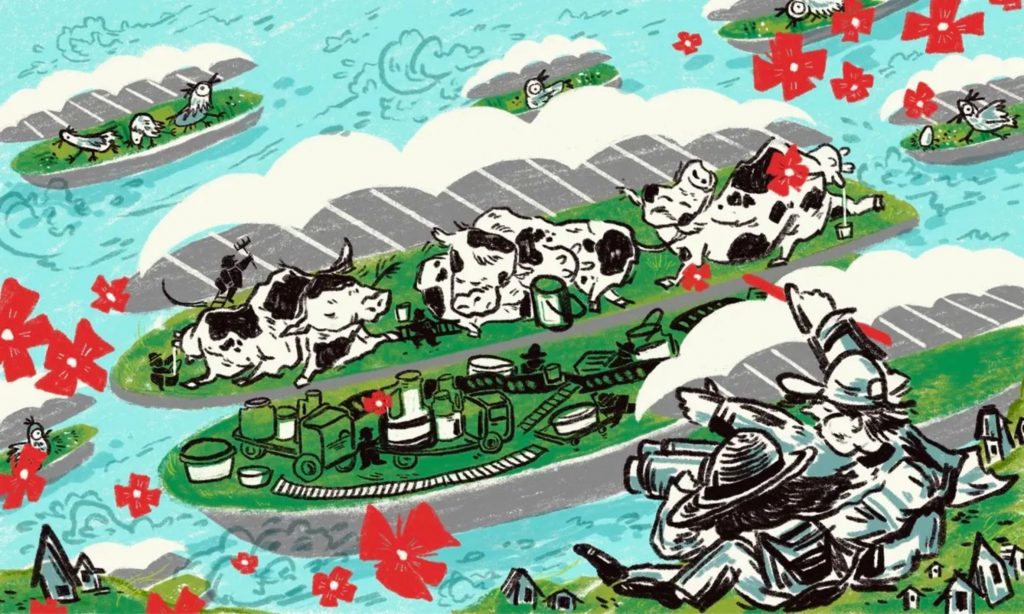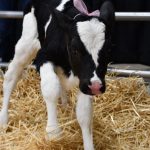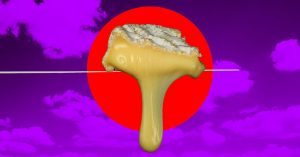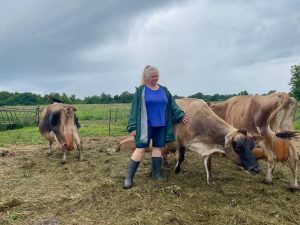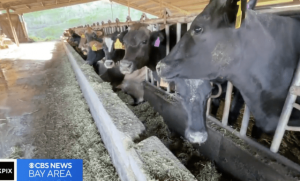
Samuel L Jackson can have his snakes on a plane. Peter and Minke van Wingerden have concocted something even wilder: a herd of cows floating on the sea.
The Dutch husband-and-wife team’s experiment on sustainable agriculture, a hi-tech micro-dairy called Floating Farm, can be found bobbing in the port of Rotterdam. The modernist structure houses 40 Maas-Rijn-Ijssel cows, who collectively produce some 200 gallons (757 liters) of milk a day. In addition to helping nourish the local community, the waterborne farm is playing a part in the global conversation about how the climate crisis is pushing farmers to reconsider how – and where – they produce food.
Floods, extreme heating, megadroughts and even rising night temperatures have sent the food system off its axis and cost the US farm industry alone over $1bn. The race to outsmart the constant onslaught of extreme weather is well under way: a team of scientists in Mexico is developing wheat strains that are climate-resilient, while Jack’s Solar Garden in Longmont, Colorado, is a testbed for the emerging method of agrivoltaic farming – a space-efficient system that allows for solar arrays and traditional farming to coexist on the same patch of land, a multi-tasking innovation that proponents say results in a greater crop yield than traditional farming. “If you have a strong ecological system underneath the solar panels”, says Byron Kominek, Jack’s third-generation owner, “you’re able to have a win-win for climate change.”
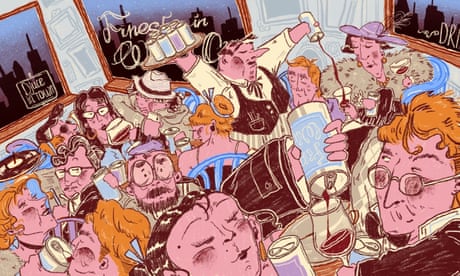
Joshua Faulkner, a research assistant professor and the program coordinator for the University of Vermont’s farming and climate change program, says extreme weather has rendered the world of farming unrecognizable from what it was only decades ago. “Farmers used to be able to count on certain things being normal, like dates of planting and dates of harvesting. Over the past 10 to 15 years, these assumptions have been thrown out the window and farmers are having to rewrite the book.”
For their part, the Van Wingerdens are betting on a method that does without the land altogether. A former property developer with a background in engineering, Peter found his inspiration for the Floating Farm in a climate catastrophe half a world away. On a visit to New York City in the aftermath of 2012’s Hurricane Sandy, which battered the north-east US, he saw how flooding hampered the delivery of fresh food to millions, a problem he was all but certain would become more severe in the coming years. So he turned to his expertise in aquatic architecture and created nearly 10,000 sq ft (929 sq meters) of space for farming that floats on the water. If successful, his experiment would not be vulnerable to rising sea levels or destructive floods.
Rotterdam has already established itself as one of the most climate-adaptive places in the world. Everything from office buildings to entire neighborhoods are built on water in the city, which is 90% below sea level. The Van Wingerdens’ floating dairy farm was a new but inevitable twist. Should a weather crisis arise, a waterborne farm isn’t necessarily stuck in place. An urban farm that serves city dwellers also reduces carbon emissions associated with food transportation. And a farm on water also helps to take a little pressure off the “global land squeeze”, a term conservationists use to describe the ever-growing tension that arises when a finite amount of land results in an increasing amount of wild terrain being given over to agriculture in order to serve the appetite for “food, feed, fuel and fiber”, explains Janet Ranganathan, the managing director for strategy, learning and results at the World Resources Institute, a global research-based NGO that focuses on sustainable land use.
The Van Wingerdens’ experimental farm floats on pontoons, rising and falling with the tides (which, in Rotterdam, fluctuate about eight feet each day). The rubber-floored barn occupying the top level of the structure is where the cows are robotically milked, mucked and fed (they can also walk down a gangplank to a waterside patch of pasture). The middle level is where the milk is processed into butter, yogurt and other dairy products. It is on this level where rain and desalinated seawater are purified for the cows’ consumption. The animals’ manure, meanwhile, is processed for fertilizer that is used on local soccer fields – whose grass clippings return as feed. At the bottom of the structure is a naturally cool space used for ripening up to 1,000 wheels of gouda-style cheese at a time, some flavored with curry, others with wild garlic – all for sale through the farm shop. In other words, it’s a circular system that is self-sustaining – not just ecologically, but economically.
The Van Wingerdens’ model is ripe for reproduction – which is exactly what the Floating Farm’s team of 14 are working on now. Plans are in the works for a floating vegetable farm to move into the space next to the current Floating Farm. Permit applications are also out for similar structures in Dubai, Singapore and the Dutch cities of Haarlem and Arnhem.
The new ventures will apply lessons learned from the original Rotterdam project. “You need to build a house in order to know how to build a house,” Peter says. Some of his key takeaways have been practical, such as those to do with mechanics on how farm materials flow through a waterborne structure. He’s also learned a great deal about dealing with bureaucracy and entrenched thinking.
The biggest obstacles he sees ahead are not financial or physical, but rather political and administrative. “As a world, we are in such a need to find solutions for the upcoming 30 years,” Peter says. “One of the biggest challenges we come across worldwide is regulations. Cities need to have disruptive thinking. Cities need to have disruptive departments. Cities need to have areas where you can say: OK, this is the experimental zone.” Because what Peter and his team are pulling off is of a different order than your typical sustainability measures. “We are not innovative,” he says. “We are disruptive.”
